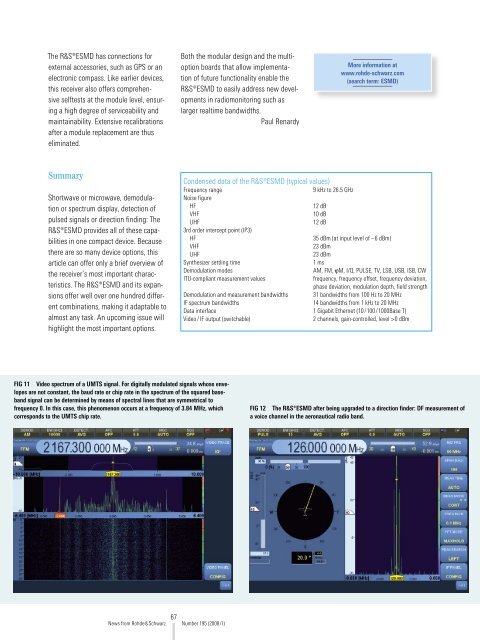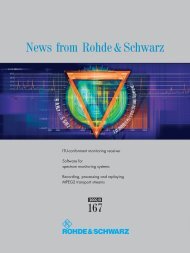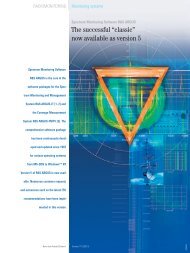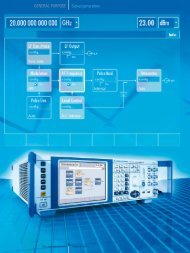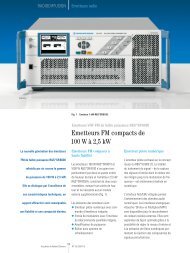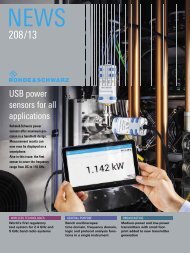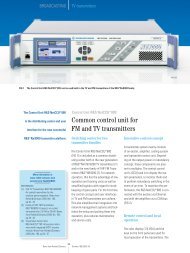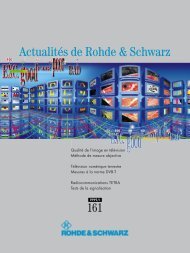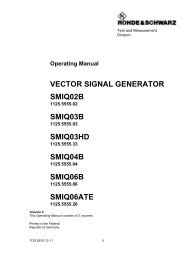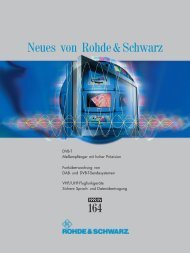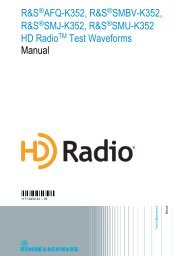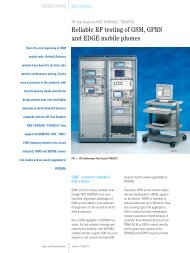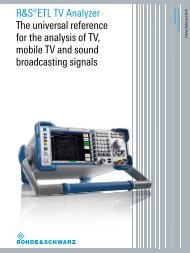The radiomonitoring specialist - Rohde & Schwarz
The radiomonitoring specialist - Rohde & Schwarz
The radiomonitoring specialist - Rohde & Schwarz
Create successful ePaper yourself
Turn your PDF publications into a flip-book with our unique Google optimized e-Paper software.
<strong>The</strong> R&S ® ESMD has connections forexternal accessories, such as GPS or anelectronic compass. Like earlier devices,this receiver also offers comprehensiveselftests at the module level, ensuringa high degree of serviceability andmaintainability. Extensive recalibrationsafter a module replacement are thuseliminated.Both the modular design and the multioptionboards that allow implementationof future functionality enable theR&S ® ESMD to easily address new developmentsin <strong>radiomonitoring</strong> such aslarger realtime bandwidths.Paul RenardyMore information atwww.rohde-schwarz.com(search term: ESMD)SummaryShortwave or microwave, demodulationor spectrum display, detection ofpulsed signals or direction finding: <strong>The</strong>R&S ® ESMD provides all of these capabilitiesin one compact device. Becausethere are so many device options, thisarticle can offer only a brief overview ofthe receiver’s most important characteristics.<strong>The</strong> R&S ® ESMD and its expansionsoffer well over one hundred differentcombinations, making it adaptable toalmost any task. An upcoming issue willhighlight the most important options.Condensed data of the R&S ® ESMD (typical values)Frequency range9 kHz to 26.5 GHzNoise figureHF12 dBVHF10 dBUHF12 dB3rd order intercept point (IP3)HF35 dBm (at input level of –6 dBm)VHF23 dBmUHF23 dBmSynthesizer settling time1 msDemodulation modesAM, FM, ϕM, I/Q, PULSE, TV, LSB, USB, ISB, CWITU-compliant measurement valuesfrequency, frequency offset, frequency deviation,phase deviation, modulation depth, field strengthDemodulation and measurement bandwidths 31 bandwidths from 100 Hz to 20 MHzIF spectrum bandwidths14 bandwidths from 1 kHz to 20 MHzData interface 1 Gigabit Ethernet (10/100/1000Base T)Video / IF output (switchable)2 channels, gain-controlled, level >0 dBmFIG 11 Video spectrum of a UMTS signal. For digitally modulated signals whose envelopesare not constant, the baud rate or chip rate in the spectrum of the squared basebandsignal can be determined by means of spectral lines that are symmetrical tofrequency 0. In this case, this phenomenon occurs at a frequency of 3.84 MHz, whichcorresponds to the UMTS chip rate.FIG 12 <strong>The</strong> R&S ® ESMD after being upgraded to a direction finder: DF measurement ofa voice channel in the aeronautical radio band.67News from <strong>Rohde</strong>&<strong>Schwarz</strong> Number 195 (2008/I)


